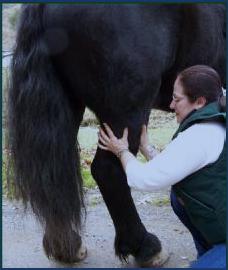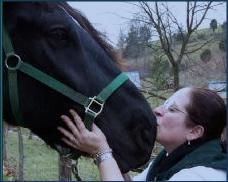| Home Medical Index | First Posted Feb 14, 2009 Jan 21, 2020 | |
Equine Massage TherapyMy husband and I attended a Seminar on February 8th that dealt with subjects such as equine dentistry, joint problems, saddle fitting, and equine massage. Hope O'Toole gave a hands on demonstration that was outstanding! She was excellent. The mare who was the recipient of this wonderful massage had a number of issues. The before and after was amazing. There was no doubt that the mare felt much better after the massage therapy. Her way of going was less rigid, her body language was much improved, and as Hope worked you could see the mare relax and enjoy. The following is reproduced on HorseHints with the permission of Hope O'Toole. Thank you, Hope, for allowing me to share this with those who come to HorseHints.The beautiful Percheron Heavy Draft Horse is Huey. He belongs to Hope and used in driving, riding, and hugging. What a sweet boy! Equine Massage
Gaining Credibility and Popularity by Hope O'Toole at 304-897-7073 As a compliment to traditional western medicine, many people have been trying less traditional therapies, including massage therapy. Equine massage therapy has its roots in human massage. By adapting the techniques used for humans to equine musculature, horses can now benefit from this non-drug, non-invasive therapy. By combining modern veterinary medicine with massage therapy, today's horses have the potential to be in better physical condition than possible in the past. Massage therapy acts exclusively on the horse's muscles. However by improving muscle condition, the benefits reach into every cell of the horse's body. Skilled hands apply different strokes, at different pressures, to treat the muscles.

Benefits and Effects of Massage
By rhythmically applying various pressures to the muscles, the muscle fibers are moved and manipulated, freeing restrictions and adhesions, and restoring blood circulation. The increased blood flow speeds nutrients to the cells, while carrying away metabolic waste products and toxins. In effect, the muscle is being worked without the muscle expending energy. When a muscle is in spasm, massage can increase circulation to soften the muscle, while moving the fibers to restore normal motion, thus reducing and even eliminating the spasm.
Manipulation of the muscle tissues and increased circulation, decreases and prevents the formation of adhesions (reducing the danger of fibrosis) by lengthening the connective tissues of the muscles. The circulation of the lymphatic system is also encouraged, which promotes elimination of more waste products and other toxins. Although massage does not work directly on the joints, the manipulation and circulation benefits improve joint health. The result is reduced inflammation and swelling, decreased joint pain, increased production of synovial fluid, and increased joint flexibility. Therapeutic massage releases endorphins, which eases pain and generally makes the horse feel better. The result of all these benefits of massage therapy, is a horse with reduced physical and mental tension, and an improved disposition. Everyone who handles horses, knows how attitude affects performance. Equine massage therapy can improve the physical and mental performance of show horses, race horses, work horses, brood mares, and pets. In other words, massage can improve the health of all horses. Equine massage is used to repair and heal injured or sore muscles. But, equine massage excels as a preventive - by improving muscle tone and flexibility to reduce strains and damage from exercise, work, or accidents. A maintenance massage program acts much like feeding a horse nutritional supplements. By promoting good health, the time the horse spends in poor health is reduced. It is more costly in time, money, and energy to heal a horse, than it is to maintain the horse in good health.
Certified Equine Massage Therapists
Equine massage therapists are trained similarly to the way human massage therapists are trained. There are a number of fine equine massage therapy schools around the US. Equine therapists study anatomy and physiology of the horse. Being able to identify the different muscle groups, and understanding the muscles' functions, are necessary for placement and application of the massage strokes. Therapists are taught a variety of massage strokes. Each muscle group requires a different sequence and application of these strokes. If simple memorization of anatomy, and the sequences of stroke application and pressures were sufficient to massage a horse, a robot could do it. Each equine massage therapist must learn to interpret the communication from the horse. Subtle indications from each horse, lead the therapist to the exact location of muscle tension. The therapist adjusts the pressure used with each massage stroke, by interpreting signals from the horse and the muscles. An effective equine massage therapist customizes each massage for that specific horse, on that specific day.
  
An Unexpected Benefit
Everyone who works with horses (or any other animal) has felt enriched by the experience. Developing communication and working together with horses lifts the soul. The communication and connection a massage therapist feels with each of the horses, is special and is therapeutic for both horse and human. From front to back, and top to bottom, all the muscles are treated methodically. Sealed with a kiss.

The Author
Hope O'Toole, is a certified equine and canine massage therapist, with 15 years experience. She massages all equines, from mini donkeys to heavy draft horses, in the Northern Virginia and Eastern West Virginia regions. For more information, please contact Hope O'Toole at 304-897-7073.
© Black Water 2004 |